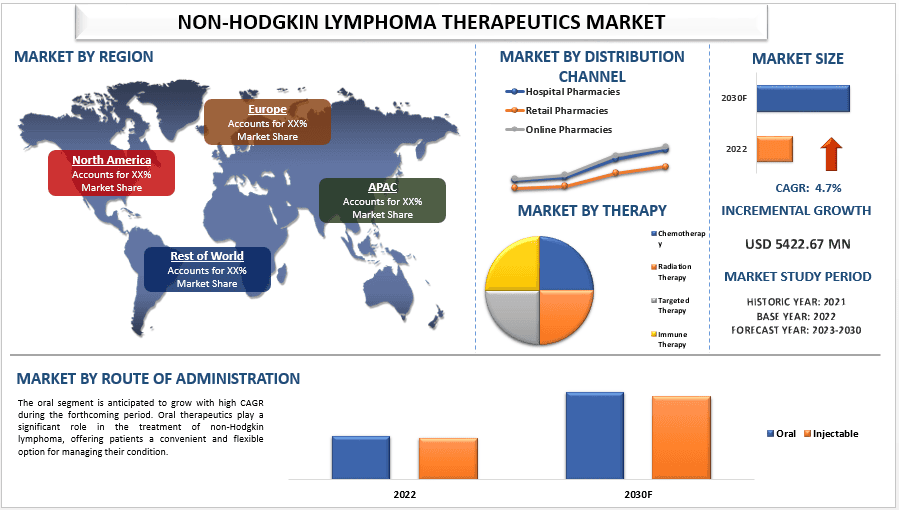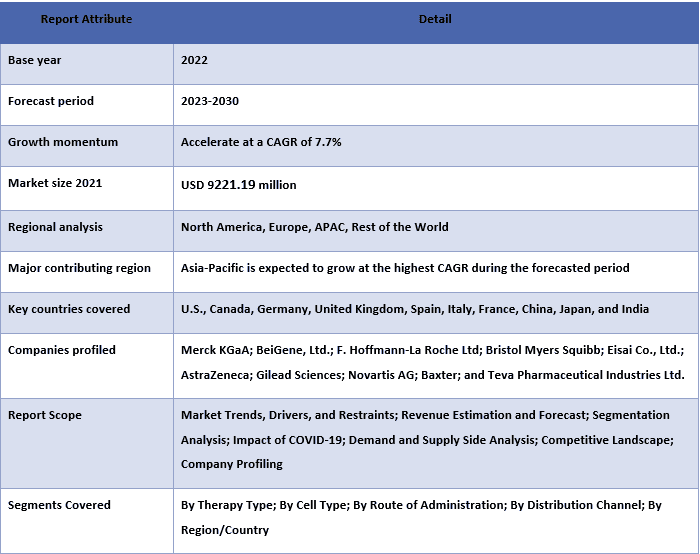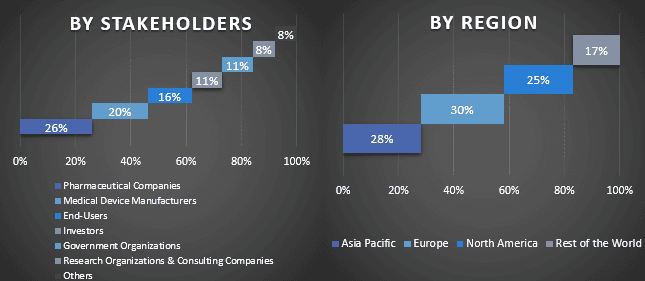- Home
- About Us
- Industry
- Services
- Reading
- Contact Us
Non-Hodgkin Lymphoma Therapeutics Market: Current Analysis and Forecast (2023-2030)
Emphasis on Therapy Type (Chemotherapy, Radiation Therapy, Targeted Therapy, and Immune Therapy); Cell Type (B-cell lymphoma and T-cell lymphoma); Route of Administration (Oral and Injectable); Distribution Channel (Hospital Pharmacies, Retail Pharmacies, and Online Pharmacies); and Region/Country.

The non-Hodgkin lymphoma therapeutics market was valued at USD 9221.19 Million in 2022 and is expected to grow at a strong CAGR of around 7.7% during the forecast period (2023-2030) owing to rising number of clinical trials. The non-Hodgkin lymphoma therapeutics market has witnessed a significant growth in recent years, and one prominent driving factor behind this trend is the rising number of clinical trials conducted in this field. Clinical trials play a crucial role in the development and advancement of therapies for non-Hodgkin lymphoma, a type of cancer that affects the lymphatic system. These trials are designed to rigorously evaluate the safety and efficacy of new treatments, including novel drugs, immunotherapies, and targeted therapies specifically tailored for non-Hodgkin lymphoma. The increasing number of clinical trials indicates a growing interest and commitment from researchers, pharmaceutical companies, and healthcare professionals to find better treatment options for patients facing this challenging disease.
Some of the major players operating in the market Merck KGaA; BeiGene, Ltd.; F. Hoffmann-La Roche Ltd; Bristol Myers Squibb; Eisai Co., Ltd.; AstraZeneca; Gilead Sciences; Novartis AG; Baxter; and Teva Pharmaceutical Industries Ltd. Several M&As along with partnerships have been undertaken by these players to facilitate customers with hi-tech and innovative products/technologies.
Insights Presented in the Report
“Amongst therapy type, the chemotherapy category held significant share of the market in 2022”
On the basis of therapy type, the market is categorized into chemotherapy, radiation therapy, targeted therapy, and immune therapy. The chemotherapy segment held dominant share in the non-Hodgkin lymphoma (NHL) therapeutics market in 2022. Non-Hodgkin lymphoma refers to a diverse group of cancers that originate in the lymphatic system, which is an essential part of the immune system. Chemotherapy is one of the primary treatment options for NHL and involves the use of drugs to destroy cancer cells. The chemotherapy segment in the non-Hodgkin lymphoma therapeutics market continues to evolve. Researchers and pharmaceutical companies are developing new chemotherapy drugs with improved efficacy and reduced side effects. Additionally, efforts are being made to develop personalized chemotherapy regimens by considering gene mutations and other factors unique to each patient, leading to more tailored and effective treatments.
“Amongst route of administration, the oral category to grow with significant CAGR during the forecast period”
On the basis of the route of administration, the market is bifurcated into oral and injectable. The oral segment is anticipated to grow with high CAGR during the forthcoming period. Oral therapeutics play a significant role in the treatment of non-Hodgkin lymphoma, offering patients a convenient and flexible option for managing their condition. These medications are administered orally, either in the form of tablets or capsules, allowing patients to take them at home without the need for intravenous infusions or hospital visits. In recent years, there have been several advancements in oral therapeutics for non-Hodgkin lymphoma, aimed at improving treatment outcomes and quality of life for patients. These advancements include the development of new targeted therapies and immunotherapies.
“Amongst distribution channel, the oral category to grow with significant CAGR during the forecast period”
Based on distribution channel, the market is segmented into hospital pharmacies, retail pharmacies, and online pharmacies. The online pharmacies is expected to grow with high CAGR during the forthcoming period. Online pharmacies have rapidly gained prominence in recent years, transforming the way people access and purchase medications. As an increasingly popular choice for consumers worldwide, these virtual platforms offer a convenient and accessible means of obtaining prescription drugs and over-the-counter medications. The driving factors behind the rise of online pharmacies can be attributed to several key aspects. Firstly, the convenience factor cannot be overstated, as these platforms allow individuals to order medications from the comfort of their homes, saving valuable time and effort. Additionally, online pharmacies often offer a wide range of products, making it easier for customers to find specific medications that may not be readily available in local brick-and-mortar pharmacies. Furthermore, the competitive pricing provided by online pharmacies, coupled with attractive discounts and deals, makes them an appealing option for cost-conscious consumers.
“APAC to grow with high CAGR during forthcoming years”
APAC is anticipated to grow with high CAGR during the forthcoming period. The Asia Pacific non-Hodgkin lymphoma therapeutics market has been witnessing remarkable growth, primarily driven by factors such as increasing prevalence of NHL, improving healthcare infrastructure, expanding access to healthcare facilities, and rising awareness about the disease. Additionally, advancements in medical technology and significant investments in research and development activities in the region further contribute to the market growth. Countries like China, Japan, India, South Korea, and Australia are major contributors to the Asia Pacific non-Hodgkin lymphoma therapeutics market. These countries are witnessing a surge in the incidence of NHL cases due to factors such as changing lifestyles, pollution, genetic factors, and aging populations. As a result, there is an urgent need for innovative treatment options to combat this disease effectively.
Non-Hodgkin Lymphoma Therapeutics Market Report Coverage

Reasons to buy this report:
- The study includes market sizing and forecasting analysis validated by authenticated key industry experts.
- The report presents a quick review of overall industry performance at one glance.
- The report covers an in-depth analysis of prominent industry peers with a primary focus on key business financials, product portfolios, expansion strategies, and recent developments.
- Detailed examination of drivers, restraints, key trends, and opportunities prevailing in the industry.
- The study comprehensively covers the market across different segments.
- Deep dive regional level analysis of the industry.
Customization Options:
The global non-Hodgkin lymphoma therapeutics market can further be customized as per the requirement or any other market segment. Besides this, UMI understands that you may have your own business needs, hence feel free to connect with us to get a report that completely suits your requirements.
Table of Content
Research Methodology for the Non-Hodgkin Lymphoma Therapeutics Market Analysis (2023-2030)
Analyzing the historical market, estimating the current market, and forecasting the future market of the global non-Hodgkin lymphoma therapeutics market were the three major steps undertaken to create and analyze the adoption of non-Hodgkin lymphoma therapeutics in major regions globally. Exhaustive secondary research was conducted to collect the historical market numbers and estimate the current market size. Secondly, to validate these insights, numerous findings and assumptions were taken into consideration. Moreover, exhaustive primary interviews were also conducted, with industry experts across the value chain of the global non-Hodgkin lymphoma therapeutics market. Post assumption and validation of market numbers through primary interviews, we employed a top-down/bottom-up approach to forecasting the complete market size. Thereafter, market breakdown and data triangulation methods were adopted to estimate and analyze the market size of segments and sub-segments of the industry pertains to. Detailed methodology is explained below:
Analysis of Historical Market Size
Step 1: In-Depth Study of Secondary Sources:
Detail secondary study was conducted to obtain the historical market size of the non-Hodgkin lymphoma therapeutics market through company internal sources such as annual reports & financial statements, performance presentations, press releases, etc., and external sources including journals, news & articles, government publications, competitor publications, sector reports, third-party database, and other credible publications.
Step 2: Market Segmentation:
After obtaining the historical market size of the non-Hodgkin lymphoma therapeutics market, we conducted a detailed secondary analysis to gather historical market insights and share for different segments & sub-segments for major regions. Major segments are included in the report as therapy type, cell type, route of administration, and distribution channel. Further country-level analyses were conducted to evaluate the overall adoption of testing models in that region.
Step 3: Factor Analysis:
After acquiring the historical market size of different segments and sub-segments, we conducted a detailed factor analysis to estimate the current market size of the non-Hodgkin lymphoma therapeutics market. Further, we conducted factor analysis using dependent and independent variables such as therapy type, cell type, route of administration, and distribution channel of the non-Hodgkin lymphoma therapeutics market. A thorough analysis was conducted for demand and supply-side scenarios considering top partnerships, mergers and acquisitions, business expansion, and product launches in the non-Hodgkin lymphoma therapeutics market sector across the globe.
Current Market Size Estimate & Forecast
Current Market Sizing: Based on actionable insights from the above 3 steps, we arrived at the current market size, key players in the global non-Hodgkin lymphoma therapeutics market, and market shares of the segments. All the required percentage shares split, and market breakdowns were determined using the above-mentioned secondary approach and were verified through primary interviews.
Estimation & Forecasting: For market estimation and forecast, weights were assigned to different factors including drivers & trends, restraints, and opportunities available for the stakeholders. After analyzing these factors, relevant forecasting techniques i.e., the top-down/bottom-up approach were applied to arrive at the market forecast for 2030 for different segments and sub-segments across the major markets globally. The research methodology adopted to estimate the market size encompasses:
- The industry’s market size, in terms of revenue (USD) and the adoption rate of the non-Hodgkin lymphoma therapeutics market across the major markets domestically
- All percentage shares, splits, and breakdowns of market segments and sub-segments
- Key players in the global non-Hodgkin lymphoma therapeutics market in terms of products offered. Also, the growth strategies adopted by these players to compete in the fast-growing market
Market Size and Share Validation
Primary Research: In-depth interviews were conducted with the Key Opinion Leaders (KOLs) including Top Level Executives (CXO/VPs, Sales Head, Marketing Head, Operational Head, Regional Head, Country Head, etc.) across major regions. Primary research findings were then summarized, and statistical analysis was performed to prove the stated hypothesis. Inputs from primary research were consolidated with secondary findings, hence turning information into actionable insights.
Split of Primary Participants in Different Regions

Market Engineering
The data triangulation technique was employed to complete the overall market estimation and to arrive at precise statistical numbers for each segment and sub-segment of the global non-Hodgkin lymphoma therapeutics market. data was split into several segments & sub-segments post studying various parameters and trends in the areas of the therapy type, cell type, route of administration, and distribution channel in the global non-Hodgkin lymphoma therapeutics market.
The main objective of the Global Non-Hodgkin Lymphoma Therapeutics Market Study
The current & future market trends of the global non-Hodgkin lymphoma therapeutics market were pinpointed in the study. Investors can gain strategic insights to base their discretion for investments on the qualitative and quantitative analysis performed in the study. Current and future market trends determined the overall attractiveness of the market at a regional level, providing a platform for the industrial participant to exploit the untapped market to benefit from a first-mover advantage. Other quantitative goals of the studies include:
- Analyze the current and forecast market size of the non-Hodgkin lymphoma therapeutics market in terms of value (USD). Also, analyze the current and forecast market size of different segments and sub-segments
- Segments in the study include areas of the therapy type, cell type, route of administration, and distribution channel.
- Define and analysis of the regulatory framework for the non-Hodgkin lymphoma therapeutics industry
- Analyze the value chain involved with the presence of various intermediaries, along with analyzing customer and competitor behaviors of the industry
- Analyze the current and forecast market size of the non-Hodgkin lymphoma therapeutics market for the major region
- Major countries of regions studied in the report include Asia Pacific, Europe, North America, and the Rest of the World
- Company profiles of the non-Hodgkin lymphoma therapeutics market and the growth strategies adopted by the market players to sustain in the fast-growing market
- Deep dive regional level analysis of the industry
Frequently Asked Questions FAQs
Q1: What is the current market size and growth potential of the global XX market?
Q2: What are the driving factors for the growth of the global non-Hodgkin lymphoma therapeutics Market?
Q3: Which segment has the largest share of the global non-Hodgkin lymphoma therapeutics market by TherapyType?
Q4: What are the emerging technologies and trends in the global non-Hodgkin lymphoma therapeutics market?
Q5: Which region will dominate the global non-Hodgkin lymphoma therapeutics market?
Q6: Who are the key players operating in the global non-Hodgkin lymphoma therapeutics market?
Related Reports
Customers who bought this item also bought










